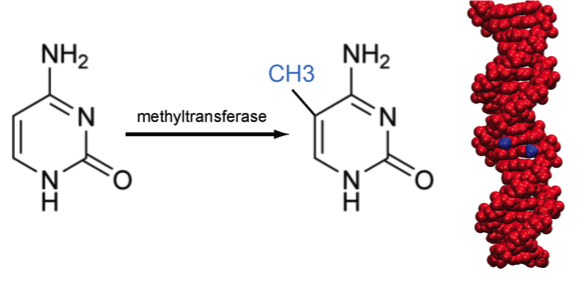KSH 0611 Review Epigenetic modifications regulate gene expression
Contents
- 1 Epigenetics
- 1.1 Definition : Heritable changes in gene activity and expression that occur without alteration in DNA sequence
- 1.2 Different cells control switching on and off in different genes
- 1.3 Two well-known epigenetic modifications
- 1.4 Why is it important ? >>> Epigenetic modifications regulate gene activity and expression during development and differentiation, or in response to environmental stimuli
- 1.5 Epigenetics is considered a bridge between genotype and phenotype
- 1.6 Explain how cells carrying identical DNA differentiate into different cell types >>> Epigenetics
- 1.7 Epigenome - global analyses of epigenetic markers across the entire genome
- 1.8 Chromatin - Histone protein / DNA complex in eukaryotic cells
- 1.9 How to regulate Protein Synthesis - Epigenetic inheritance controls the amount of the transcribed mRNA. Thus, protein production is regulated.
- 1.10 Only 2 % of human genome encodes protein and the other 98% controls gene expression by epigenetic mechanism.
- 1.11 Application
- 1.12 How could epigenetic inheritance lead monozygotic twins to different ways?
- 1.13 Reference
Epigenetics
Definition : Heritable changes in gene activity and expression that occur without alteration in DNA sequence
Different cells control switching on and off in different genes
Two well-known epigenetic modifications
-
Chemical modification to the cytosine residues of DNA (DNA methylation)
DNA methylation usually occurs in cytosine followed by guanine (CpG) by DNA methyltransferase
Most CpG motifs (Repetitive short pattern in DNA sequence or Protein sequence) are located near promoter regions.1)
Promoter is a region of DNA that initiates transcription of a particular gene
The region that has lots of CpG motifs is called CpG island.
Among around 60% of protein-encoding DNA sequences, their promoters are located in CpG islands.
When a gene is activated, the methylation level of a nearby CpG island is low.
When the gene switches off, the methylation level of the nearby CpG island is high.
MeCP2(Methyl CpG binding protein 2) - acts as a decoder. It only binds to the methylated CpG islands2) and recruits other 'switching off' proteins3).
As a result, DNA is tightly packed and transcription factors cannot access to the promoter region
The methylation pattern is inherited to the daughter cells
 (
( )
)
 (
( )
)
 (
( )
)
-
Histone modification
More than 50 kinds of histone modifications have been known.
Most well known example is histone acetylation
Histone acetylation is the process that lysine resides from the histone core of the nucleosome are acetylated by histone acetyltransferase
Scientists encounter a problem that which kind of combination is used for gene activation or gene inactivation.
Why is it important ? >>> Epigenetic modifications regulate gene activity and expression during development and differentiation, or in response to environmental stimuli
Epigenetics is considered a bridge between genotype and phenotype
Explain how cells carrying identical DNA differentiate into different cell types >>> Epigenetics
Epigenome - global analyses of epigenetic markers across the entire genome
Chromatin - Histone protein / DNA complex in eukaryotic cells
Basic Unit - nucleosome - 146 bp of DNA wrapped around an octamer of the four core histones (H2A, H2B, H3 and H4)
- Euchromatin - transcriptionally active state - the region where DNA is accessible due to the relaxed state of nucleosome arrangement
- Heterochromatin - transcriptionally inactive state - the area where DNA is packed into highly condensed forms that are inaccessible to transcription factors
How to regulate Protein Synthesis - Epigenetic inheritance controls the amount of the transcribed mRNA. Thus, protein production is regulated.
Ex) Alcohol dehydrogenase (ADH) breaks down alcohol in liver cells.
We could increase the mRNA of ADH and then make ADH more than usual when we drink much
Only 2 % of human genome encodes protein and the other 98% controls gene expression by epigenetic mechanism.
Application
1. Neurological defects could be recovered by correctly recognizing DNA methylation pettern4)
Rett syndrome, one of the severe mental retardation diseases, is mostly caused by MeCP2 mutation
MeCP2 is a protein that decodes DNA methylated regions. If MeCP2 is mutated, we cannot decode these epigenetic codes.
There is a vidio 5) about recovering mentar redardation by activating normal MeCP2 gene using certain chemacals in a mouce.
It suggests that we could develop therapies for diverse mental development disorders by studying epigenetics in the future.
How could epigenetic inheritance lead monozygotic twins to different ways?
The Power of Random Epigenetic Modification - X chromosome inactivation
One of the copies of X chromosome in a woman is inactivated by random selection
When one woman has a mutation gene in one x chromosome, it could be recovered by the other x chromosome.
For example, Duchenne dystrophy is a severe muscular atrophy. It results from X chromosome-related DYSTROPHIN mutation6)
Most of the heterozygous women who have only one DYSTROPHIN mutation gene don't show the symptom because they have the cells which select normal DYSTROPHIN gene and the cells can help nearby mutated cells
Reference
1) Bird, Adrian P. "CpG-rich islands and the function of DNA methylation." Nature321.6067 (1985): 209-213.
2) Meehan, Richard, Joe D. Lewis, and Adrian P. Bird. "Characterization of MeCP2, a vertebrate DNA binding protein with affinity for methylated DNA."Nucleic acids research 20.19 (1992): 5085-5092.
3) Nan, Xinsheng, et al. "Transcriptional repression by the methyl-CpG-binding protein MeCP2 involves a histone deacetylase complex." Nature 393.6683 (1998): 386-389.
4) Guy, Jacky, et al. "Reversal of neurological defects in a mouse model of Rett syndrome." Science 315.5815 (2007): 1143-1147.
5) https://www.youtube.com/watch?v=RyAvKGmAElQ&feature=related
6) Nessa, Carey. The Epigenetics Revolution, 247p, Bookhouse Publishers, 2011